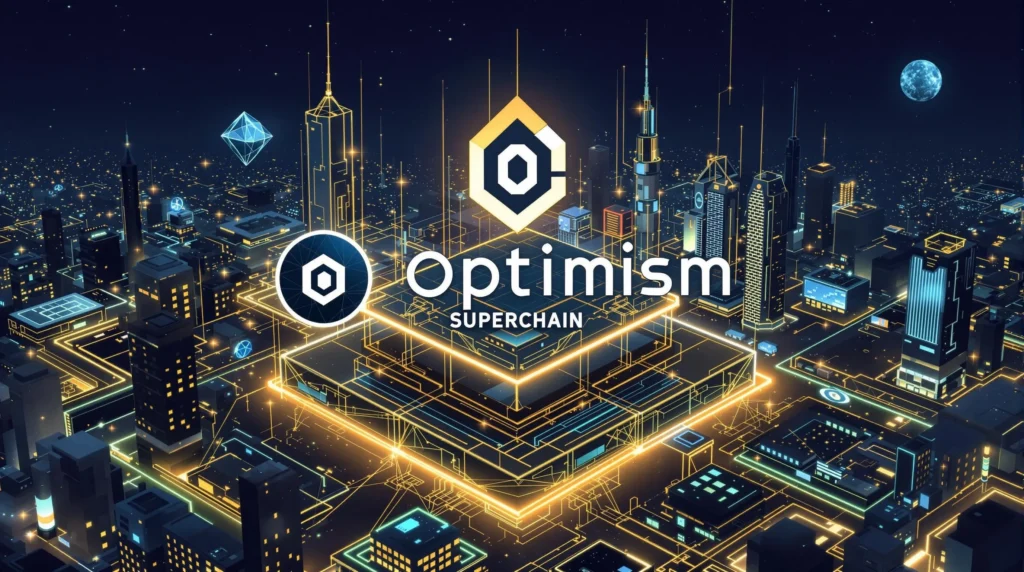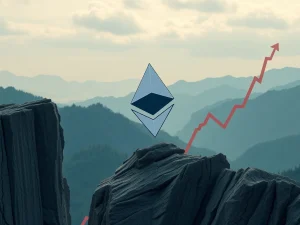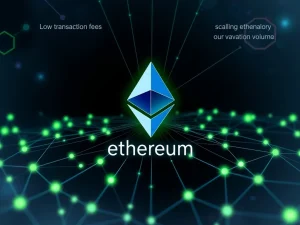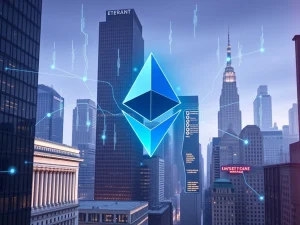Dominant Optimism Superchain: To Command 80% of Ethereum Layer 2 Transactions by 2025?

Get ready for a seismic shift in the Ethereum Layer 2 (L2) landscape! Optimism, a major player in Ethereum scaling solutions, is making bold predictions about its Superchain. According to a key executive at Optimism, the Superchain is anticipated to handle a staggering 80% of all Ethereum Layer 2 transactions by 2025. This is a monumental claim, signaling a potential consolidation of transaction volume within the Optimism ecosystem. But what exactly is the Superchain, and why is this prediction generating such buzz in the crypto community? Let’s dive into the details and explore what this could mean for the future of Ethereum scaling and the broader crypto space.
Understanding the Power of Optimism Superchain and Ethereum Layer 2 Scaling
To grasp the significance of this 80% prediction, we first need to understand the fundamentals of Ethereum Layer 2 scaling solutions. Ethereum, while being the second-largest cryptocurrency and a hub for decentralized applications (dApps), has faced scalability challenges. Its main network can get congested, leading to slow transaction speeds and high gas fees, especially during peak demand. This is where Layer 2 solutions come into play. They are designed to operate on top of the main Ethereum Layer 1, handling transactions off-chain to increase speed and reduce costs, while still benefiting from Ethereum’s security.
Optimism is one of the leading Layer 2 scaling solutions, employing a technology called Optimistic Rollups. These rollups bundle multiple transactions together and process them off-chain before submitting a summary of these transactions back to the Ethereum mainnet. This significantly reduces the load on the main Ethereum network, making transactions faster and cheaper.
Now, enter the Optimism Superchain. Imagine a network of interconnected Optimistic Rollups, all working together seamlessly. That’s essentially what the Superchain aims to be. It’s not just a single Layer 2; it’s a vision for a network of interoperable Layer 2 blockchains, all built using the OP Stack.
Key Components of the Optimism Superchain:
- OP Stack: This is the open-source, modular, and standardized development stack that powers Optimism and the Superchain. It’s like a blueprint for building Optimistic Rollups, making it easier for developers to launch new Layer 2 chains that are compatible and interoperable.
- Interoperability: The Superchain is designed for seamless communication and asset transfer between different Layer 2 chains within its ecosystem. This means users can move assets and data across these chains with minimal friction, enhancing the user experience.
- Shared Governance: While each chain within the Superchain can have its own specific features and focuses, they are intended to share a common governance structure, ensuring alignment and coordination across the network.
Why 80% of Ethereum L2 Transactions in 2025? The Bold Prediction
The prediction that the Superchain will capture 80% of crypto transactions on Ethereum Layer 2s by 2025 is ambitious, to say the least. But it’s grounded in the strategic advantages and growing adoption of the OP Stack.
Several factors contribute to this optimistic outlook:
- Ease of Deployment with OP Stack: The OP Stack significantly lowers the barrier to entry for launching new Layer 2 chains. Its modularity and pre-built components streamline the development process, making it faster and more cost-effective to create and deploy new rollups.
- Network Effects and Interoperability: As more chains join the Superchain ecosystem, the network effect strengthens. The ability to seamlessly move assets and data between chains makes the entire ecosystem more attractive to users and developers, driving further adoption.
- Brand Recognition and Trust in Optimism: Optimism has established itself as a reputable and reliable Layer 2 solution. This brand recognition and trust can attract projects and users to build and transact within the Superchain ecosystem.
- Strategic Partnerships and Adoption by Major Players: The content snippet itself highlights a crucial point: major industry players are already building on the OP Stack. Let’s delve into who these are and why it matters.
Sony, Coinbase, Kraken, and Worldcoin: Powerhouses Embracing the OP Stack
The mention of Sony, Coinbase, Kraken, and Sam Altman’s World (likely referring to Worldcoin) building on the OP Stack is a powerful validation of Optimism’s vision. These are not small startups; they are established global entities with significant user bases and influence.
- Coinbase: A leading cryptocurrency exchange, Coinbase is building its own Layer 2 network, Base, using the OP Stack. This move is significant as it brings a massive user base directly into the Optimism ecosystem. Coinbase’s adoption signals confidence in the technology and its potential for scaling crypto adoption.
- Kraken: Another major cryptocurrency exchange, Kraken, is also exploring Layer 2 solutions and the OP Stack. While details might be less public than Coinbase’s Base, Kraken’s potential involvement further solidifies the OP Stack’s appeal to large exchanges.
- Sony: A global entertainment and technology conglomerate, Sony’s interest in the OP Stack suggests broader applications beyond just finance. While the specific use case might be under wraps, Sony’s involvement points to the versatility of the OP Stack for various industries, potentially including gaming, NFTs, or digital identity.
- Worldcoin (Sam Altman’s World): Worldcoin, co-founded by Sam Altman of OpenAI, is a project focused on creating a global digital identity and currency. Building on the OP Stack suggests that Worldcoin sees the Superchain as a robust and scalable infrastructure for its ambitious goals, potentially involving high volumes of transactions related to digital identity and currency distribution.
The fact that these diverse and influential organizations are choosing to build on the OP Stack is a strong indicator of the Superchain’s potential to become a dominant force in the Ethereum Layer 2 space. Their adoption brings not only user volume but also credibility and further development resources to the ecosystem.
Benefits of the Superchain and OP Stack: Why is Everyone So Excited?
The excitement surrounding the Superchain and OP Stack is not unfounded. They offer a range of compelling benefits for developers, users, and the Ethereum ecosystem as a whole:
- Scalability and Throughput: By distributing transaction load across multiple interconnected Layer 2 chains, the Superchain can achieve significantly higher transaction throughput than a single Layer 2 or the Ethereum mainnet alone. This improved scalability is crucial for mass adoption of decentralized applications.
- Reduced Gas Fees: Layer 2 solutions inherently offer lower gas fees compared to Ethereum Layer 1. The Superchain further optimizes gas efficiency by allowing chains to specialize and potentially share resources, leading to even more affordable transactions for users.
- Customization and Flexibility: The OP Stack’s modular design allows developers to customize their Layer 2 chains to suit specific needs. They can choose different data availability solutions, governance models, and feature sets, providing greater flexibility than a one-size-fits-all approach.
- Interoperability and Composability: The Superchain fosters a highly interoperable environment. Assets and data can move seamlessly between chains, enabling complex and innovative applications that leverage the strengths of different Layer 2s within the ecosystem. This composability is a key advantage for developers building interconnected decentralized applications.
- Open-Source and Community-Driven: The OP Stack is open-source, encouraging community contributions and innovation. This decentralized and collaborative approach can lead to faster development, greater resilience, and broader adoption.
Challenges and Considerations for Superchain Dominance
While the outlook for the Superchain is bright, it’s important to acknowledge potential challenges and considerations:
- Competition from Other Layer 2 Solutions: The Ethereum Layer 2 landscape is competitive. Solutions like Arbitrum, zkSync, and StarkNet are also vying for market share. Optimism needs to maintain its technological edge and continue to attract projects and users to achieve its 80% target.
- Execution Risks and Technological Hurdles: Building a complex, interoperable Superchain is a significant undertaking. There are technical challenges related to cross-chain communication, shared governance, and ensuring the security and stability of the entire network.
- Adoption Rate and User Education: Even with strong technology, widespread adoption requires user awareness and education. Efforts are needed to make Layer 2 solutions and the Superchain easy to understand and use for the average crypto user.
- Centralization Concerns: While the OP Stack is open-source, the initial development and direction are heavily influenced by the Optimism team. Ensuring sufficient decentralization and community governance as the Superchain grows will be crucial to maintain trust and long-term viability.
The Road Ahead: Superchain and the Future of Ethereum
The prediction that the Optimism Superchain will handle 80% of Ethereum transactions on Layer 2s by 2025 is a powerful statement about the future of Ethereum scaling. Fueled by the robust OP Stack, the growing ecosystem, and the backing of major industry players like Coinbase, Kraken, Sony, and Worldcoin, the Superchain is undeniably positioned for significant growth.
Whether it reaches the ambitious 80% target remains to be seen. However, the underlying trend is clear: Layer 2 solutions are essential for Ethereum’s scalability, and the Superchain, with its focus on interoperability and developer-friendliness, is a compelling vision for the future. Keep a close watch on the Optimism ecosystem – it’s shaping up to be a central pillar of the evolving Ethereum landscape and the broader crypto world.
Key Takeaways:
- Optimism predicts its Superchain will handle 80% of Ethereum Layer 2 transactions by 2025.
- The Superchain is a network of interoperable Layer 2 blockchains built using the open-source OP Stack.
- Major companies like Coinbase, Kraken, Sony, and Worldcoin are building on the OP Stack, indicating strong industry adoption.
- The Superchain offers benefits like scalability, lower gas fees, customization, and interoperability.
- Challenges include competition, execution risks, adoption rates, and decentralization concerns.
The Optimism Superchain is a project with the potential to revolutionize how we think about Ethereum scaling. Its success could pave the way for a more scalable, affordable, and user-friendly decentralized future.









